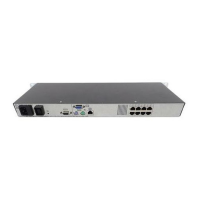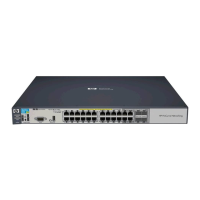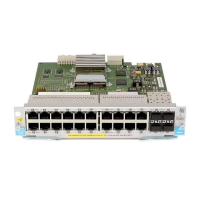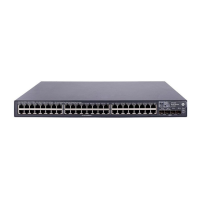92
[DeviceC-mst-region] active region-configuration
[DeviceC-mst-region] quit
# Specify the current device as the root bridge of MSTI 4.
[DeviceC] stp instance 4 root primary
# Enable the spanning tree feature globally.
[DeviceC] stp enable
5. Configure Device D:
# Enter MST region view, configure the MST region name as example, map VLAN 10, VLAN 30,
and VLAN 40 to MSTI 1, MSTI 3, and MSTI 4, respectively, and configure the revision level of
the MST region as 0.
<DeviceD> system-view
[DeviceD] stp region-configuration
[DeviceD-mst-region] region-name example
[DeviceD-mst-region] instance 1 vlan 10
[DeviceD-mst-region] instance 3 vlan 30
[DeviceD-mst-region] instance 4 vlan 40
[DeviceD-mst-region] revision-level 0
# Activate MST region configuration.
[DeviceD-mst-region] active region-configuration
[DeviceD-mst-region] quit
# Enable the spanning tree feature globally.
[DeviceD] stp enable
6. Verify the configurations:
In this example, suppose that Device B has the lowest root bridge ID. As a result, Device B is
elected as the root bridge in MSTI 0.
You can use the display stp brief command to display brief spanning tree information on each
device after the network is stable.
# Display brief spanning tree information on Device A.
[DeviceA] display stp brief
MSTID Port Role STP State Protection
0 Ethernet1/0/1 ALTE DISCARDING NONE
0 Ethernet1/0/2 DESI FORWARDING NONE
0 Ethernet1/0/3 ROOT FORWARDING NONE
1 Ethernet1/0/1 DESI FORWARDING NONE
1 Ethernet1/0/3 DESI FORWARDING NONE
3 Ethernet1/0/2 DESI FORWARDING NONE
3 Ethernet1/0/3 ROOT FORWARDING NONE
# Display brief spanning tree information on Device B.
[DeviceB] display stp brief
MSTID Port Role STP State Protection
0 Ethernet1/0/1 DESI FORWARDING NONE
0 Ethernet1/0/2 DESI FORWARDING NONE
0 Ethernet1/0/3 DESI FORWARDING NONE
1 Ethernet1/0/2 DESI FORWARDING NONE
1 Ethernet1/0/3 ROOT FORWARDING NONE
3 Ethernet1/0/1 DESI FORWARDING NONE
3 Ethernet1/0/3 DESI FORWARDING NONE
# Display brief spanning tree information on Device C.
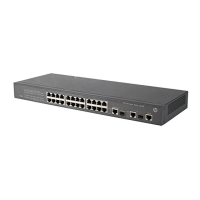
